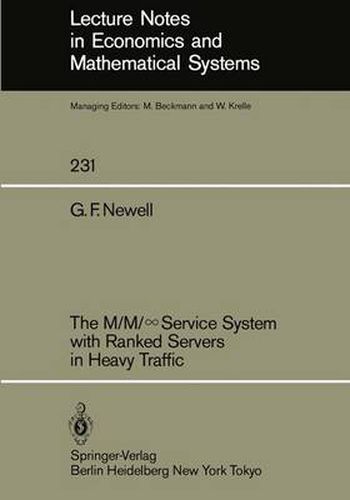Readings Newsletter
Become a Readings Member to make your shopping experience even easier.
Sign in or sign up for free!
You’re not far away from qualifying for FREE standard shipping within Australia
You’ve qualified for FREE standard shipping within Australia
The cart is loading…






This title is printed to order. This book may have been self-published. If so, we cannot guarantee the quality of the content. In the main most books will have gone through the editing process however some may not. We therefore suggest that you be aware of this before ordering this book. If in doubt check either the author or publisher’s details as we are unable to accept any returns unless they are faulty. Please contact us if you have any questions.
We are concerned here with a service facility consisting of a large (- finite) number of servers in parallel. The service times for all servers are identical, but there is a preferential ordering of the servers. Each newly arriving customer enters the lowest ranked available server and remains there until his service is completed. It is assumed that customers arrive according to a Poisson process of rate A , that all servers have exponentially distributed service times with rate ~ and that a = A/~ is large compared with 1. Generally, we are concerned with the stochastic properties of the random function N(s ,t) describing the number of busy servers among the first s ordered servers at time t. Most of the analysis is motivated by special applications of this model to telephone traffic. If one has a brunk line with s primary channels, but a large number (00) of secondary (overflow) channels, each newly arriving customer is assigned to one of the primary channels if any are free; otherwise, he is assigned to a secondary channel. The primary and secondary channels themselves could have a preferential ordering. For some purposes, it is convenient to imagine that they did even if an ordering is irrelevant.
$9.00 standard shipping within Australia
FREE standard shipping within Australia for orders over $100.00
Express & International shipping calculated at checkout
This title is printed to order. This book may have been self-published. If so, we cannot guarantee the quality of the content. In the main most books will have gone through the editing process however some may not. We therefore suggest that you be aware of this before ordering this book. If in doubt check either the author or publisher’s details as we are unable to accept any returns unless they are faulty. Please contact us if you have any questions.
We are concerned here with a service facility consisting of a large (- finite) number of servers in parallel. The service times for all servers are identical, but there is a preferential ordering of the servers. Each newly arriving customer enters the lowest ranked available server and remains there until his service is completed. It is assumed that customers arrive according to a Poisson process of rate A , that all servers have exponentially distributed service times with rate ~ and that a = A/~ is large compared with 1. Generally, we are concerned with the stochastic properties of the random function N(s ,t) describing the number of busy servers among the first s ordered servers at time t. Most of the analysis is motivated by special applications of this model to telephone traffic. If one has a brunk line with s primary channels, but a large number (00) of secondary (overflow) channels, each newly arriving customer is assigned to one of the primary channels if any are free; otherwise, he is assigned to a secondary channel. The primary and secondary channels themselves could have a preferential ordering. For some purposes, it is convenient to imagine that they did even if an ordering is irrelevant.